Abstract
Recent models of the urinary concentrating mechanism have postulated that urea in the medullary interstitium creates a transtubular concentration gradient for sodium between fluid at the end of the descending limb of Henle's loop and the medullary interstitium, favoring the passive outward movement of sodium from Henle's thin ascending limb. These experiments were designed to determine whether such a gradient normally exists. Young nondiuretic Munich-Wistar rats were prepared for micropuncture of the exposed left renal papilla. Samples of loop of Henle fluid and vasa recta plasma (assumed to reflect the composition of interstitial fluid) were obtained from adjacent sites. Loop fluid values in 21 comparisons from 18 rats (mean +/- SE) were: sodium 344 +/- 12 meq/liter; potassium, 26 +/- 2 meq/liter; osmolality, 938 +/- 37 mosmol/kg H23. Vasa recta plasma values (in corresponding units of measurement) were: sodium, 284 +/- 11; potassium, 34 +/- 2; osmolality, 935 +/- 34. Mean values of paired differences (loop fluid minus vasa recta plasma) were: delta sodium, 60 +/- 11.1 (P less than 0.001); delta potassium, -8.0 +/- 2.1 (P less than 0.001); delta osmolality, 4 +/- 16 (NS). Corrected for plasma water, the loop fluid minus vasa recta differences (in milliequivalents per kilogram H2O) were: delta sodium, 40 +/- 11.4 (P less than 0.005); delta potassium, -9.7 +/- 1.9 (P less than 0.001). We interpret these findings to indicate that in the papilla of nondiuretic rats, a significant difference in sodium concentration exists across the thin loop of Henle favoring outward movement of sodium, which confirms a key requirement of the passive models. A concentration difference for potassium in the reverse direction was also observed.
Full text
PDF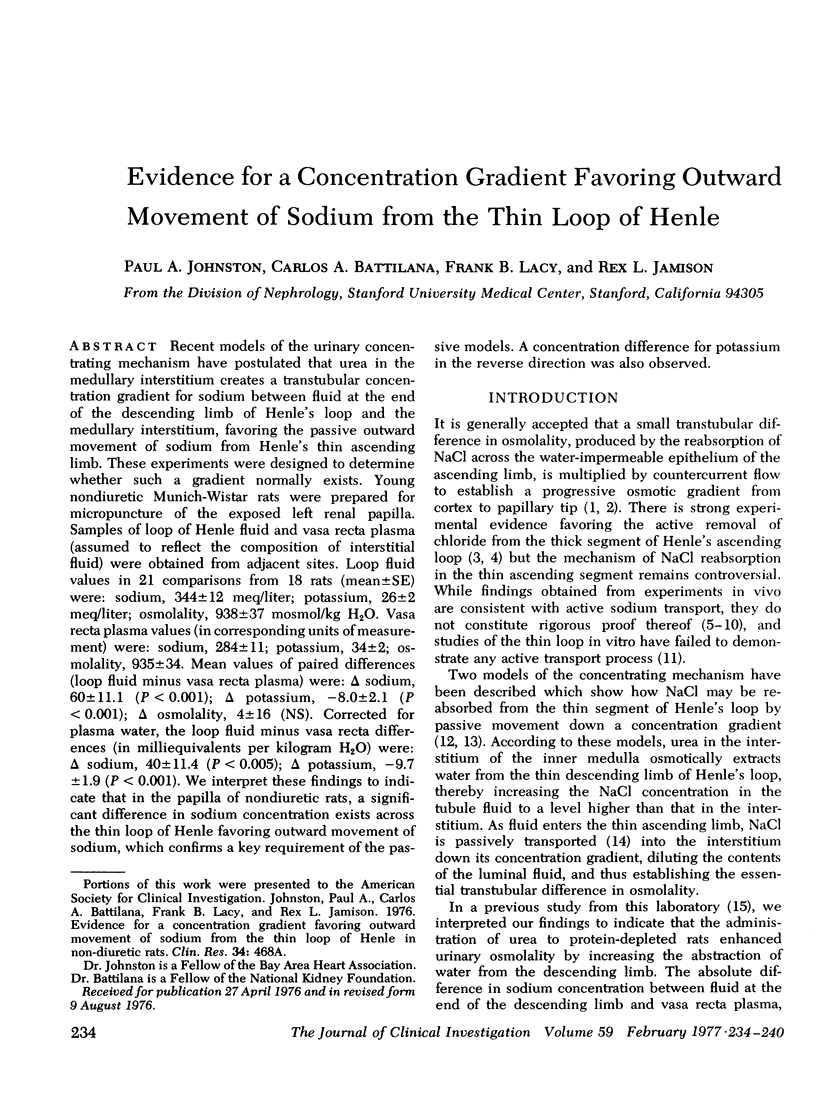
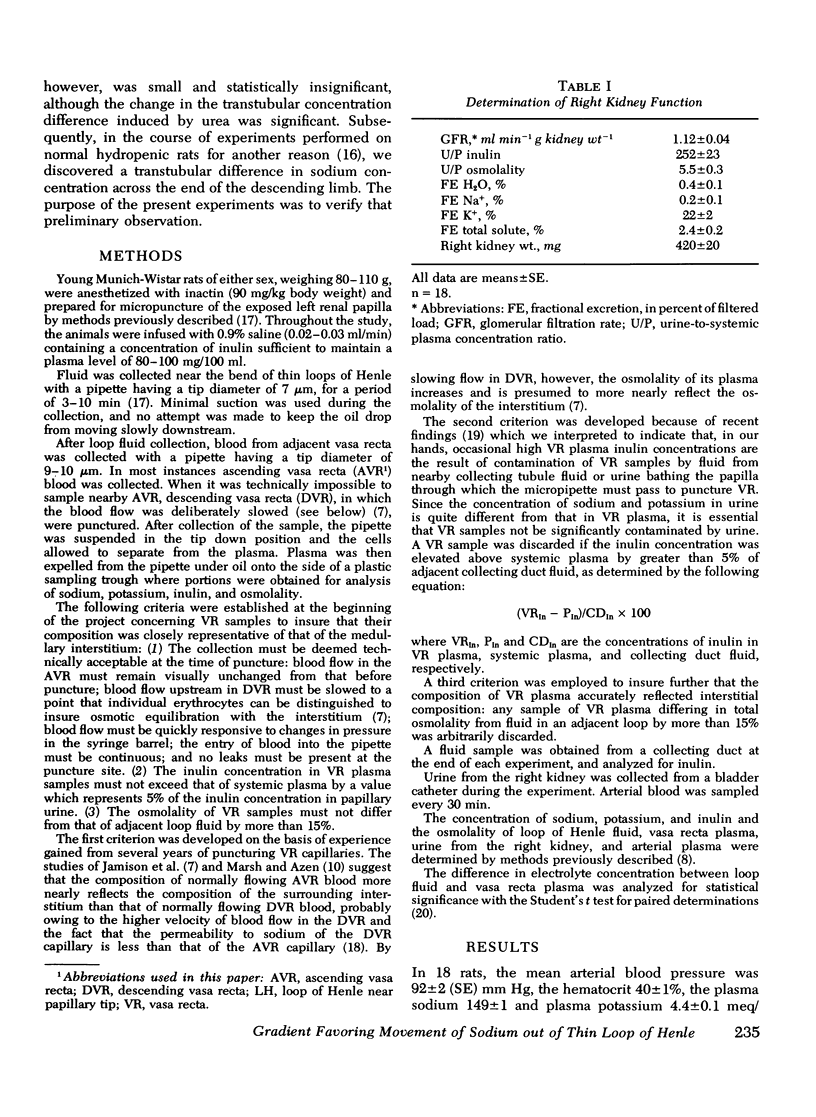
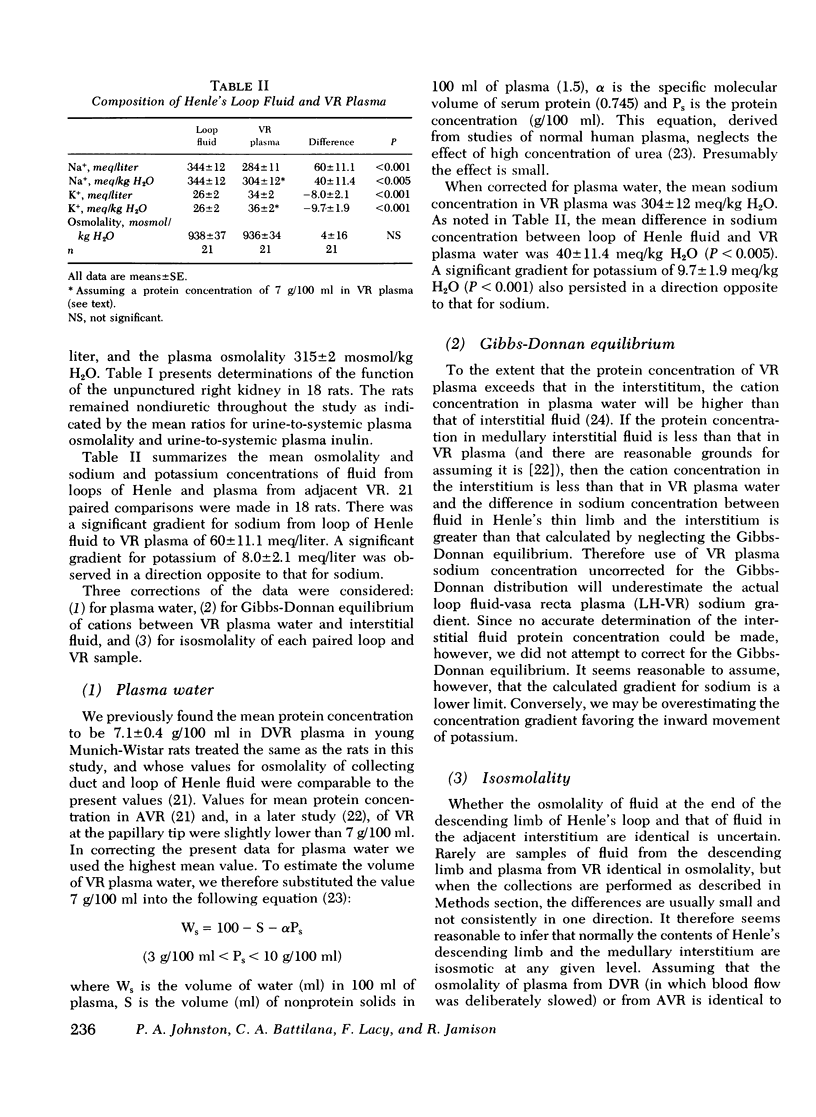
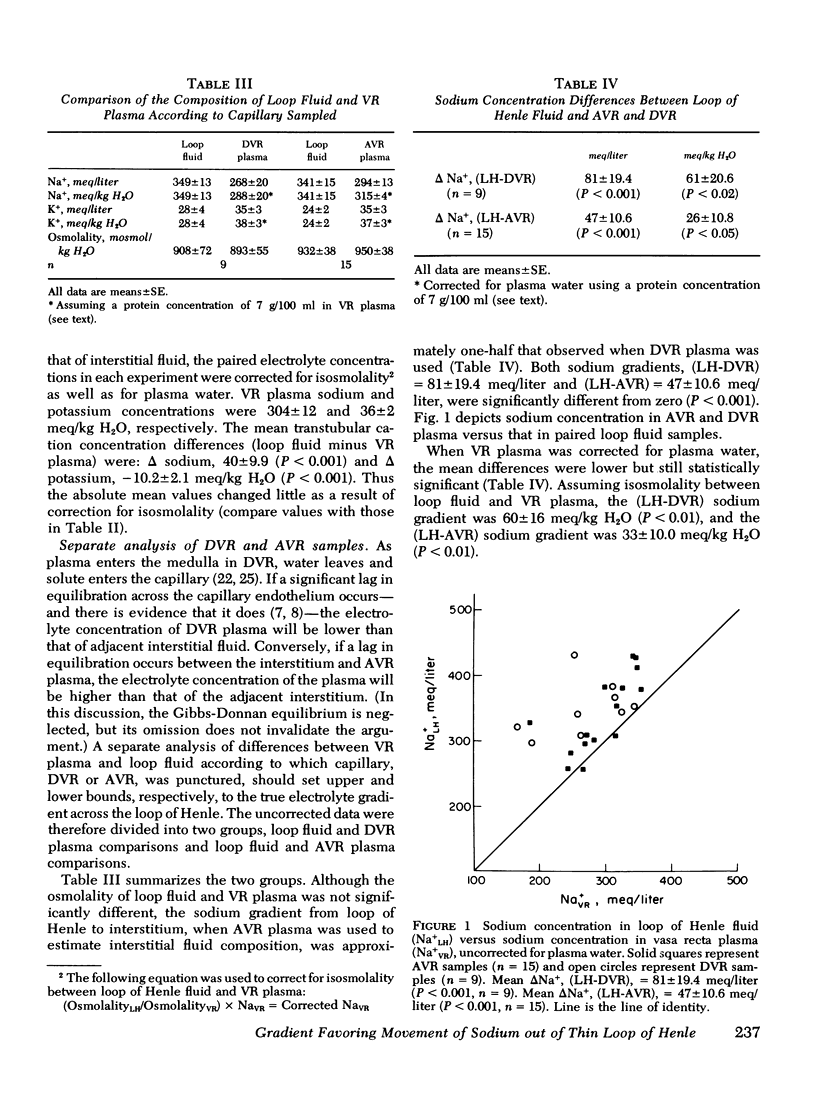
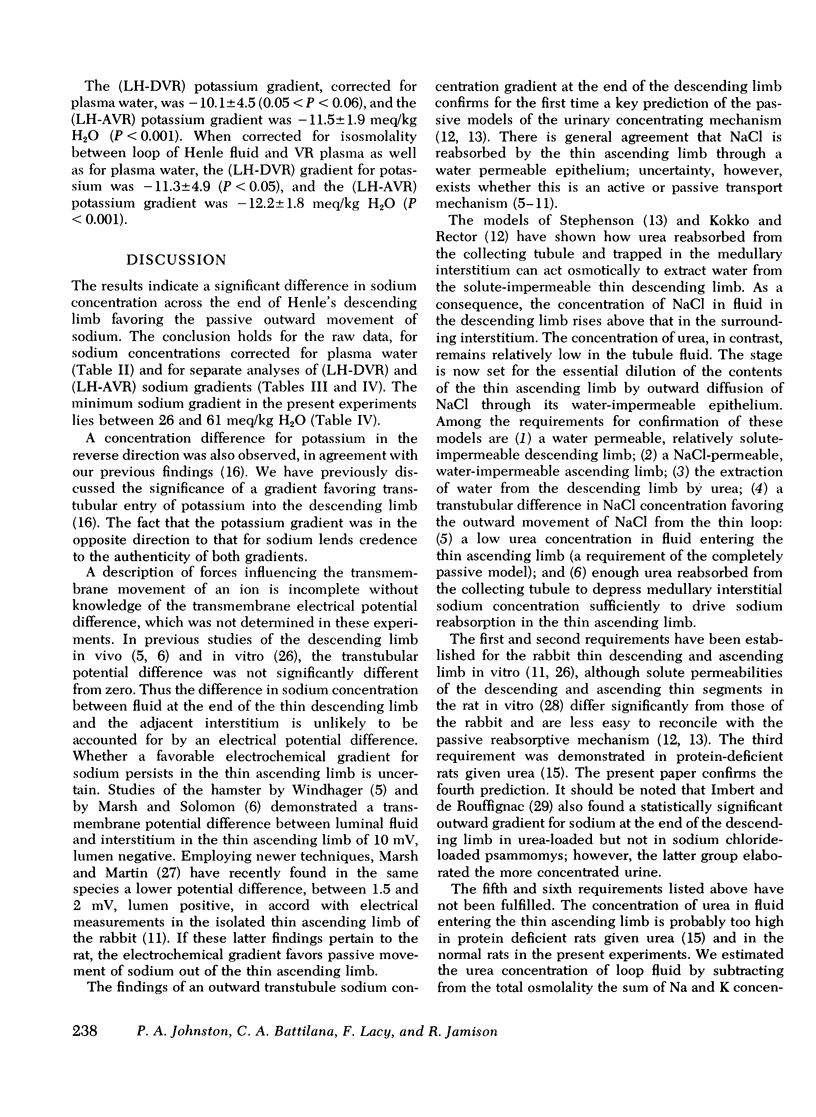
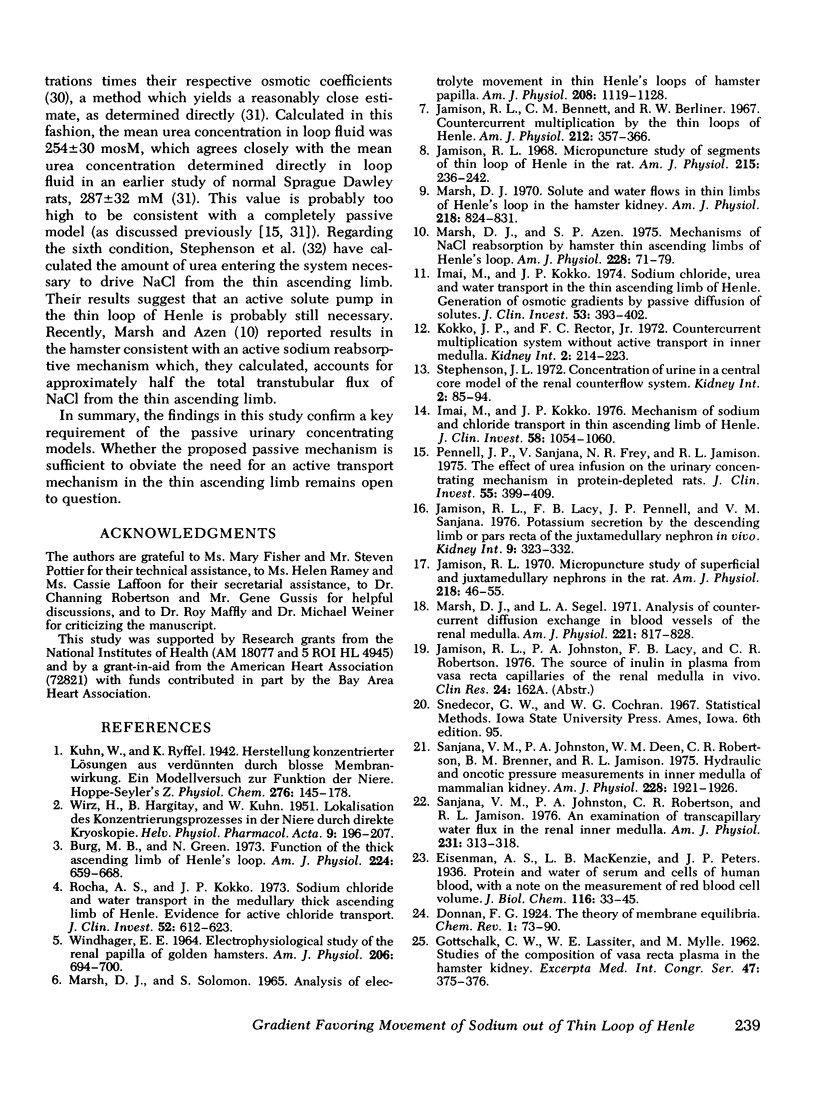
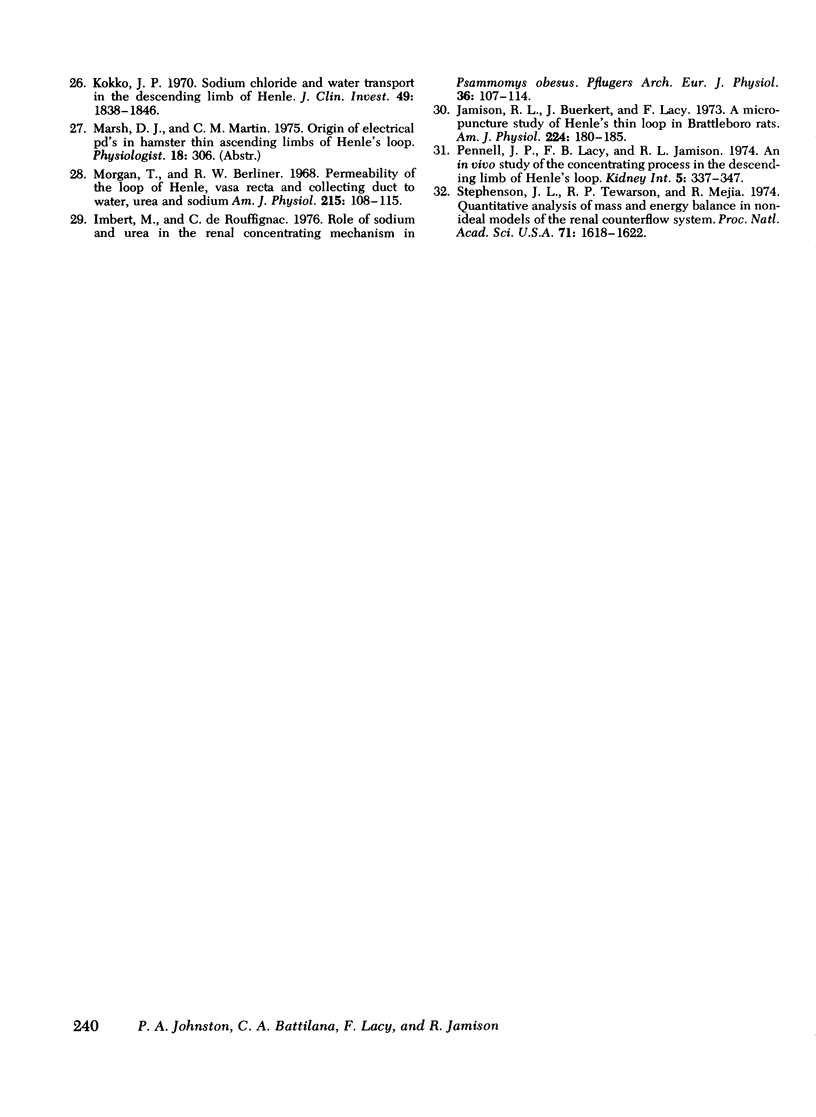
Selected References
These references are in PubMed. This may not be the complete list of references from this article.
- Burg M. B., Green N. Function of the thick ascending limb of Henle's loop. Am J Physiol. 1973 Mar;224(3):659–668. doi: 10.1152/ajplegacy.1973.224.3.659. [DOI] [PubMed] [Google Scholar]
- Imai M., Kokko J. P. Mechanism of sodium and chloride transport in the thin ascending limb of Henle. J Clin Invest. 1976 Nov;58(5):1054–1060. doi: 10.1172/JCI108556. [DOI] [PMC free article] [PubMed] [Google Scholar]
- Imai M., Kokko J. P. Sodium chloride, urea, and water transport in the thin ascending limb of Henle. Generation of osmotic gradients by passive diffusion of solutes. J Clin Invest. 1974 Feb;53(2):393–402. doi: 10.1172/JCI107572. [DOI] [PMC free article] [PubMed] [Google Scholar]
- Imbert M., de Rouffignac C. Role of sodium and urea in the renal concentrating mechanism in Psammomys obesus. Pflugers Arch. 1976 Jan 30;361(2):107–114. doi: 10.1007/BF00583453. [DOI] [PubMed] [Google Scholar]
- Jamison R. L., Bennett C. M., Berliner R. W. Countercurrent multiplication by the thin loops of Henle. Am J Physiol. 1967 Feb;212(2):357–366. doi: 10.1152/ajplegacy.1967.212.2.357. [DOI] [PubMed] [Google Scholar]
- Jamison R. L., Buerkert J., Lacy F. A micropuncture study of Henle's thin loop in Brattleboro rats. Am J Physiol. 1973 Jan;224(1):180–185. doi: 10.1152/ajplegacy.1973.224.1.180. [DOI] [PubMed] [Google Scholar]
- Jamison R. L., Lacy F. B., Pennell J. P., Sanjana V. M. Potassium secretion by the decending limb or pars recta of the juxtamedullary nephron in vivo. Kidney Int. 1976 Apr;9(4):323–332. doi: 10.1038/ki.1976.38. [DOI] [PubMed] [Google Scholar]
- Jamison R. L. Micropuncture study of segments of thin loop of Henle in the rat. Am J Physiol. 1968 Jul;215(1):236–242. doi: 10.1152/ajplegacy.1968.215.1.236. [DOI] [PubMed] [Google Scholar]
- Jamison R. L. Micropuncture study of superficial and juxtamedullary nephrons in the rat. Am J Physiol. 1970 Jan;218(1):46–55. doi: 10.1152/ajplegacy.1970.218.1.46. [DOI] [PubMed] [Google Scholar]
- Kokko J. P., Rector F. C., Jr Countercurrent multiplication system without active transport in inner medulla. Kidney Int. 1972 Oct;2(4):214–223. doi: 10.1038/ki.1972.97. [DOI] [PubMed] [Google Scholar]
- Kokko J. P. Sodium chloride and water transport in the descending limb of Henle. J Clin Invest. 1970 Oct;49(10):1838–1846. doi: 10.1172/JCI106401. [DOI] [PMC free article] [PubMed] [Google Scholar]
- MARSH D. J., SOLOMON S. ANALYSIS OF ELECTROLYTE MOVEMENT IN THIN HENLE'S LOOPS OF HAMSTER PAPILLA. Am J Physiol. 1965 Jun;208:1119–1128. doi: 10.1152/ajplegacy.1965.208.6.1119. [DOI] [PubMed] [Google Scholar]
- Marsh D. J., Azen S. P. Mechanism of NaCl reabsorption by hamster thin ascending limbs of Henle's loop. Am J Physiol. 1975 Jan;228(1):71–79. doi: 10.1152/ajplegacy.1975.228.1.71. [DOI] [PubMed] [Google Scholar]
- Marsh D. J., Segel L. A. Analysis of countercurrent diffusion exchange in blood vessels of the renal medulla. Am J Physiol. 1971 Sep;221(3):817–828. doi: 10.1152/ajplegacy.1971.221.3.817. [DOI] [PubMed] [Google Scholar]
- Marsh D. J. Solute and water flows in thin limbs of Henle's loop in the hamster kidney. Am J Physiol. 1970 Mar;218(3):824–831. doi: 10.1152/ajplegacy.1970.218.3.824. [DOI] [PubMed] [Google Scholar]
- Morgan T., Berliner R. W. Permeability of the loop of Henle, vasa recta, and collecting duct to water, urea, and sodium. Am J Physiol. 1968 Jul;215(1):108–115. doi: 10.1152/ajplegacy.1968.215.1.108. [DOI] [PubMed] [Google Scholar]
- Pennell J. P., Lacy F. B., Jamison R. L. An in vivo study of the concentrating process in the descending limb of Henle's loop. Kidney Int. 1974 May;5(5):337–347. doi: 10.1038/ki.1974.49. [DOI] [PubMed] [Google Scholar]
- Pennell J. P., Sanjana V., Frey N. R., Jamison R. L. The effect of urea infusion on the urinary concentrating mechanism in protein-depleted rats. J Clin Invest. 1975 Feb;55(2):399–409. doi: 10.1172/JCI107944. [DOI] [PMC free article] [PubMed] [Google Scholar]
- Rocha A. S., Kokko J. P. Sodium chloride and water transport in the medullary thick ascending limb of Henle. Evidence for active chloride transport. J Clin Invest. 1973 Mar;52(3):612–623. doi: 10.1172/JCI107223. [DOI] [PMC free article] [PubMed] [Google Scholar]
- Sanjana V. M., Johnston P. A., Deen W. M., Robertson C. R., Brenner B. M., Jamison R. L. Hydraulic and oncotic pressure measurements in inner medulla of mammalian kidney. Am J Physiol. 1975 Jun;228(6):1921–1926. doi: 10.1152/ajplegacy.1975.228.6.1921. [DOI] [PubMed] [Google Scholar]
- Sanjana V. M., Johnston P. A., Robertson C. R., Jamison R. L. An examination of transcapillary water flux in renal inner medulla. Am J Physiol. 1976 Aug;231(2):313–318. doi: 10.1152/ajplegacy.1976.231.2.313. [DOI] [PubMed] [Google Scholar]
- Stephenson J. L. Concentration of urine in a central core model of the renal counterflow system. Kidney Int. 1972 Aug;2(2):85–94. doi: 10.1038/ki.1972.75. [DOI] [PubMed] [Google Scholar]
- Stephenson J. L., Tewarson R. P., Mejia R. Quantitative analysis of mass and energy balance in non-ideal models of the renal counterflow system. Proc Natl Acad Sci U S A. 1974 May;71(5):1618–1622. doi: 10.1073/pnas.71.5.1618. [DOI] [PMC free article] [PubMed] [Google Scholar]
- WINDHAGER E. E. ELECTROPHYSIOLOGICAL STUDY OF RENAL PAPILLA OF GOLDEN HAMSTERS. Am J Physiol. 1964 Apr;206:694–700. doi: 10.1152/ajplegacy.1964.206.4.694. [DOI] [PubMed] [Google Scholar]
- WIRZ H., HARGITAY B., KUHN W. Lokalisation des Konzentrierungsprozesses in der Niere durch direkte Kryoskopie. Helv Physiol Pharmacol Acta. 1951 Jun;9(2):196–207. [PubMed] [Google Scholar]


